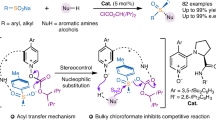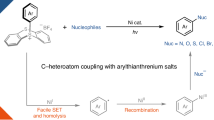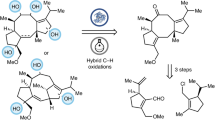Abstract
The direct incorporation of alkanes and CO into value-added chiral products through alkane carbonylation is a desirable transformation; however, it remains inefficient. The carbonylation of alkanes via photoirradiated radical addition to CO requires mild reaction conditions but suffers from low conversion due to equilibrium constraints. Here an equilibrium-leveraging strategy that combines alkane carbonylation with various enantioselective transformations is reported. The combination of tetra-n-butylammonium decatungstate and chiral sodium phosphate catalysts enables alkane carbonylation/enantioselective Mannich reaction and alkane carbonylation/enantioselective radical addition cascade processes for the enantioselective synthesis of β-amino and α-amino ketones from alkanes, CO and anilines by breaking the equilibrium of reversible photocatalytic C–H carbonylation. While both reactions can tolerate a broad scope of cyclic alkanes and anilines, the synthetic method to synthesize β-amino ketones can use a range of aliphatic ketones as substrates. The synthetic process to form β-amino ketones can be readily scaled-up through use of an integrated continuous-flow and batch set-up, providing efficient gram-scale synthesis. Mechanistic studies reveal that the synthesis of α-amino ketones proceeds through the asymmetric addition of an acyl radical to an imine intermediate.

This is a preview of subscription content, access via your institution
Access options
Subscribe to this journal
Receive 12 digital issues and online access to articles
$119.00 per year
only $9.92 per issue
Buy this article
- Purchase on Springer Link
- Instant access to full article PDF
Prices may be subject to local taxes which are calculated during checkout






Similar content being viewed by others
Data availability
Full experimental procedures and the data supporting the findings of this study are available within the Article and its Supplementary Information.
References
Ryu, I., Sonoda, N. & Curran, D. P. Tandem radical reactions of carbon monoxide, isonitriles, and other reagent equivalents of the geminal radical acceptor/radical precursor synthon. Chem. Rev. 96, 177–194 (1996).
Peng, J.-B., Geng, H.-Q. & Wu, X.-F. The chemistry of CO: carbonylation. Chem 5, 526–552 (2018).
Cai, B., Cheo, H. W., Liu, T. & Wu, J. Light-promoted organic transformations utilizing carbon-based gas molecules as feedstocks. Angew. Chem. Int. Ed. 60, 18950–18980 (2021).
Faisca Phillips, A. M. & Pombeiro, A. In Alkane Functionalization (eds Pombeiro, A. J. L. & da Silva, M. F. C. G.) Ch. 18, 476–513 (Wiley, 2019).
Liu, C., Liu, D. & Lei, A. Recent advances of transition-metal catalyzed radical oxidative cross-couplings. Acc. Chem. Res. 47, 3459–3470 (2014).
Sumino, S., Fusano, A., Fukuyama, T. & Ryu, I. Carbonylation reactions of alkyl iodides through the interplay of carbon radicals and Pd catalysts. Acc. Chem. Res. 47, 1563–1574 (2014).
Yoo, E. J., Wasa, M. & Yu, J.-Q. Pd(II)-catalyzed carbonylation of C(sp3)–H bonds: a new entry to 1,4-dicarbonyl compounds. J. Am. Chem. Soc. 132, 17378–17380 (2010).
Xie, P. et al. Palladium-catalyzed oxidative carbonylation of benzylic C–H bonds via nondirected C(sp3)–H activation. J. Am. Chem. Soc. 134, 9902–9905 (2012).
Lu, L., Qiu, F., Alhumade, H., Zhang, H. & Lei, A. Tuning the oxidative mono- or double-carbonylation of alkanes with CO by choosing a Co or Cu catalyst. ACS Catal. 12, 9664–9669 (2022).
Li, Y., Dong, K., Zhu, F., Wang, Z. & Wu, X. F. Copper-catalyzed carbonylative coupling of cycloalkanes and amides. Angew. Chem. Int. Ed. 55, 7227–7230 (2016).
Bai, S.-T., Wen, J. & Zhang, X. in The Chemical Transformations of C1 Compounds (eds Wu, X.-F., Han, B., Ding, K. & Liu, Z.) 611–666 (Wiley, 2022).
Boese, W. T. & Goldman, A. S. Alkane carbonylation photocatalyzed by aromatic ketones under high CO pressure. Tetrahedron Lett. 33, 2119–2122 (1992).
Boese, W. T. & Goldman, A. S. Photochemical cyclohexane carbonylation cocatalyzed by d8 transition metal carbonyls and aromatic ketones and aldehydes. J. Am. Chem. Soc. 114, 350–351 (1992).
Jaynes, B. S. & Hill, C. L. Radical carbonylation of alkanes via polyoxotungstate photocatalysis. J. Am. Chem. Soc. 117, 4704–4705 (1995).
Ravelli, D., Protti, S. & Fagnoni, M. Decatungstate anion for photocatalyzed “window ledge” reactions. Acc. Chem. Res. 49, 2232–2242 (2016).
Hill, C. L. Introduction of functionality into unactivated carbon-hydrogen bonds. Catalytic generation and nonconventional utilization of organic radicals. Synlett 1995, 127–132 (1995).
Perry, I. B. et al. Direct arylation of strong aliphatic C–H bonds. Nature 560, 70–75 (2018).
Ravelli, D. et al. Functionalization by decatungstate anion photocatalysis: synergistic control by polar and steric effects expands the reaction scope. ACS Catal. 8, 701–713 (2018).
Abrams, D. J., West, J. G. & Sorensen, E. J. Toward a mild dehydroformylation using base-metal catalysis. Chem. Sci. 8, 1954–1959 (2017).
Ryu, I. et al. Atom-economical synthesis of unsymmetrical ketones through photocatalyzed C–H activation of alkanes and coupling with CO and electrophilic alkenes. Angew. Chem. Int. Ed. 50, 1869–1872 (2011).
Ryu, I. et al. Efficient C–H/C–N and C–H/C–CO–N conversion via decatungstate-photoinduced alkylation of diisopropyl azodicarboxylate. Org. Lett. 15, 2554–2557 (2013).
Raymenants, F., Masson, T. M., Sanjosé-Orduna, J. & Noël, T. Efficient C(sp3)–H carbonylation of light and heavy hydrocarbons with carbon monoxide via hydrogen atom transfer photocatalysis in flow. Angew. Chem. Int. Ed. 62, e202308563 (2023).
Mayer, J. M. Understanding hydrogen atom transfer: from bond strengths to Marcus theory. Acc. Chem. Res. 44, 36–46 (2011).
Liu, W. et al. Oxidative aliphatic C–H fluorination with fluoride ion catalyzed by a manganese porphyrin. Science 337, 1322–1325 (2012).
Jeffrey, J. L., Terrett, J. A. & MacMillan, D. W. C. O–H hydrogen bonding promotes H-atom transfer from α-C–H bonds for C-alkylation of alcohols. Science 349, 1532–1536 (2015).
Chu, J. C. & Rovis, T. Amide-directed photoredox-catalysed C–C bond formation at unactivated sp3 C–H bonds. Nature 539, 272–275 (2016).
Choi, G. J., Zhu, Q., Miller, D. C., Gu, C. J. & Knowles, R. R. Catalytic alkylation of remote C–H bonds enabled by proton-coupled electron transfer. Nature 539, 268–271 (2016).
Capaldo, L., Ravelli, D. & Fagnoni, M. Direct photocatalyzed hydrogen atom transfer (HAT) for aliphatic C–H bonds elaboration. Chem. Rev. 122, 1875–1924 (2021).
Wang, P. S., Chen, D. F. & Gong, L. Z. Recent progress in asymmetric relay catalysis of metal complex with chiral phosphoric acid. Top. Curr. Chem. 378, 9 (2020).
Zhou, Q. L. Transition-metal catalysis and organocatalysis: where can progress be expected? Angew. Chem. Int. Ed. 55, 5352–5353 (2016).
Du, Z. & Shao, Z. Combining transition metal catalysis and organocatalysis—an update. Chem. Soc. Rev. 42, 1337–1378 (2013).
Uraguchi, D. & Terada, M. Chiral Brønsted acid-catalyzed direct Mannich reactions via electrophilic activation. J. Am. Chem. Soc. 126, 5356–5357 (2004).
Akiyama, T., Itoh, J., Yokota, K. & Fuchibe, K. Enantioselective Mannich-type reaction catalyzed by a chiral Brønsted acid. Angew. Chem. Int. Ed. 43, 1566–1568 (2004).
Guo, Q.-X. et al. Chiral Brønsted acid-catalyzed direct asymmetric Mannich. reaction. J. Am. Chem. Soc. 129, 3790–3791 (2007).
List, B., Pojarliev, P., Biller, W. T. & Martin, H. J. The proline-catalyzed direct asymmetric three-component Mannich reaction: scope, optimization, and application to the highly enantioselective synthesis of 1,2-amino alcohols. J. Am. Chem. Soc. 124, 827–833 (2002).
Parmar, D., Sugiono, E., Raja, S. & Rueping, M. Complete field guide to asymmetric BINOL-phosphate derived Brønsted acid and metal catalysis: history and classification by mode of activation; bronsted acidity, hydrogen bonding, ion pairing, and metal phosphates. Chem. Rev. 114, 9047–9153 (2014).
Kampen, D., Reisinger, C. M. & List, B. Chiral Brønsted acids for asymmetric organocatalysis. Top. Curr. Chem. 291, 395–456 (2010).
Akiyama, T. Stronger Brønsted acids. Chem. Rev. 107, 5744–5758 (2007).
Du, Y. et al. Aromatic β-amino-ketone derivatives as novel selective non-steroidal progesterone receptor antagonists. Bioorg. Med. Chem. 18, 4255–4268 (2010).
Shen, K., Liu, X. H., Cai, Y. F., Lin, L. L. & Feng, X. M. Facile and efficient enantioselective Strecker reaction of ketimines by chiral sodium phosphate. Chem. Eur. J. 15, 6008–6014 (2009).
Hatano, M., Ikeno, T., Matsumura, T., Torii, S. & Ishihara, K. Chiral lithium salts of phosphoric acids as Lewis acid–base conjugate catalysts for the enantioselective cyanosilylation of ketones. Adv. Synth. Catal. 350, 1776–1780 (2008).
Klussmann, M. et al. Synthesis of TRIP and analysis of phosphate salt impurities. Synlett 21, 2189–2192 (2010).
Mondal, S. et al. Enantioselective radical reactions using chiral catalysts. Chem. Rev. 122, 5842–5976 (2022).
Uchikura, T., Kamiyama, N., Mouri, T. & Akiyama, T. Visible-light-driven enantioselective radical addition to imines enabled by the excitation of a chiral phosphoric acid–imine complex. ACS Catal. 12, 5209–5216 (2022).
Garrido-Castro, A. F., Maestro, M. C. & Alemán, J. α-Functionalization of imines via visible light photoredox catalysis. Catalysts 10, 562 (2020).
Ermanis, K. et al. A computational and experimental investigation of the origin of selectivity in the chiral phosphoric acid catalyzed enantioselective Minisci reaction. J. Am. Chem. Soc. 142, 21091–21101 (2020).
Proctor, R. S. J., Davis, H. J. & Phipps, R. J. Catalytic enantioselective Minisci-type addition to heteroarenes. Science 360, 419–422 (2018).
Qi, X. K. et al. Multicomponent synthesis of α-branched tertiary and secondary amines by photocatalytic hydrogen atom transfer strategy. Org. Lett. 23, 4473–4477 (2021).
Zhang, X., Staples, R. J., Rheingold, A. L. & Wulff, W. D. Catalytic asymmetric α-iminol rearrangement: new chiral platforms. J. Am. Chem. Soc. 136, 13971–13974 (2014).
Cao, J., Su, Y. X., Zhang, X. Y. & Zhu, S. F. Highly enantioselective Brønsted acid catalyzed Heyns rearrangement. Angew. Chem. Int. Ed. 62, e202212976 (2023).
Mennen, S. M., Gipson, J. D., Kim, Y. R. & Miller, S. J. Thiazolylalanine-derived catalysts for enantioselective intermolecular aldehyde–imine cross-couplings. J. Am. Chem. Soc. 127, 1654–1655 (2005).
DiRocco, D. A. & Rovis, T. Catalytic asymmetric cross-aza-benzoin reactions of aliphatic aldehydes with N-Boc-protected imines. Angew. Chem. Int. Ed. 51, 5904–5906 (2012).
Weinberg, D. R. et al. Proton-coupled electron transfer. Chem. Rev. 112, 4016–4093 (2012).
Uraguchi, D., Kinoshita, N., Kizu, T. & Ooi, T. Synergistic catalysis of ionic Brønsted acid and photosensitizer for a redox neutral asymmetric α-coupling of N-arylaminomethanes with aldimines. J. Am. Chem. Soc. 137, 13768–13771 (2015).
Acknowledgements
This work was supported by the National Natural Science Foundation of China (22188101, 21831007, 21971231).
Author information
Authors and Affiliations
Contributions
W.-W.D. carried out most of the experimental and data analysis work. Z.-Y.H., M.S. and Y.Z. contributed to the synthesis of catalysts and the synthetic applications. Z.-Y.H. and L.-Z.G. designed the reaction and directed the project. The paper was written by Z.-Y.H. and L.-Z.G. All authors contributed to discussions.
Corresponding authors
Ethics declarations
Competing interests
The authors declare no competing interests.
Peer review
Peer review information
Nature Synthesis thanks Bin Tan, Julian West and the other, anonymous, reviewer(s) for their contribution to the peer review of this work. Primary Handling Editor: Thomas West, in collaboration with the Nature Synthesis team.
Additional information
Publisher’s note Springer Nature remains neutral with regard to jurisdictional claims in published maps and institutional affiliations.
Rights and permissions
Springer Nature or its licensor (e.g. a society or other partner) holds exclusive rights to this article under a publishing agreement with the author(s) or other rightsholder(s); author self-archiving of the accepted manuscript version of this article is solely governed by the terms of such publishing agreement and applicable law.
About this article
Cite this article
Ding, WW., He, ZY., Sayed, M. et al. Enantioselective synthesis of β- and α-amino ketones through reversible alkane carbonylation. Nat. Synth 3, 507–516 (2024). https://doi.org/10.1038/s44160-023-00476-3
Received:
Accepted:
Published:
Issue Date:
DOI: https://doi.org/10.1038/s44160-023-00476-3



